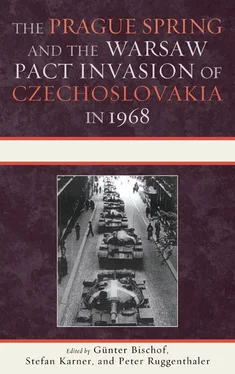To be sure, the student movement, especially in Italy, saw this change as the precursor of true socialism. But in denying the party its function of guide in favor of that of mere “coordination” of factory and student counsels, it was, in fact, undermining its Marxist-Leninist essence. 71In the end, democratic centralism could not be given up because with a genuine internal debate the PCI and PCF would have become as factionalized as the other parties. Even the FGCI gave priority to the struggle for unity with the proletariat, gaining members in the following years, but at the price of its ideological cohesion.
The intellectual diaspora was also more consequential for both parties in 1968 than in 1956 because of the combined effect of the youth rebellion, the increasing gap between intellectuals and the “complacent proletariat,” and the events in Prague. Attention to dissent had started earlier in France, with Communist intellectual Pierre Daix prefacing the first French edition of Solzhenitsyn’s One Day in the Life of Ivan Denisovich in 1963. The journal Les Lettres Françaises accepted dissident contributors beginning in 1965, and its director Louis Aragon shed all his remnant orthodoxy and called the Soviet intervention in Czechoslovakia a “Biafra of the spirit.” Roger Garaudy was expelled from the party after a critical speech at the 19th Party Congress in 1970. 72For Jean-Paul Sartre, 1968 actually changed the role of the intellectual altogether: the existentialists took an active part instead of just being moral supporters. This change was inspired in part by the Chinese model, but it ended up encouraging the individualist implications of the youth rebellion. Sartre’s condemnation of the PCF’s handling of the student movement matched his condemnation of Prague: “today the Soviet model,” he sentenced, “smothered as it is by a bureaucracy, is no longer viable.” 73
In part because of the influence of Sartre and Existentialism and in part because of economic conditions, the countercultural aspects of the youth rebellion held a broader appeal on the French Left than on the Italian Left. With its individualist pathos, the French cultural scene fielded several intellectuals who waged with fervor human rights campaigns against the Soviet Union. But the PCI had also better absorbed the intellectual dissent: the Yalta Memorandum had called for more freedom in intellectual life. The party’s Cultural Commission had been phased out in 1962 and absorbed by the more liberalized Gramsci Institute. 74
What was characteristic of left-wing intellectual autonomy in both countries was an amalgam of, on the one hand, efforts to “create a more direct and unmediated contact with the people” using such dated instruments as the wallpaper or the improved Festival de l’Unità (the annual fund-raising fair of the PCI) and, on the other hand, the triumph of the media intellectual distilling the debate, but also highly “mediating” it for the masses. The two parties’ cultural profile was raised by the apparent dialogue established with the new forms of protest that criticized Western models of development, as well as by their coming to terms with an increasingly individualized Western culture that was repelled by totalitarianism. In fact, French and Italian Communists faced two far more insidious and, for that reason, insurmountable challenges: that from consumerism and the apparently opposite one from the theories of alienation against the consumerist society which, however, turned upside down the conventional Marxist understanding of revolution in a socioeconomic sense. It was at this time that the young Marx was “exhumed,” the one with an accent on psychological more than social repression. The new generations took that philosophical turn to justify their emphasis on private desires over collective struggles. Both challenges reflected the “individualist sensibilities of the age.” 75
The U.S. culture of dissent, with its emphasis on existential problems and issues of individual expression—namely cultural alienation, women’s emancipation, the generation gap, and gay rights—subverted the economic discourse that had informed Marxist doctrines and established a transatlantic dialogue between the younger generations. In dealing with these developments, the French and Italian Communist leadership showed either rigidity (especially in the PCF) or flexibility (in the PCI) to the point of losing their ideological and political consistency altogether.
Furthermore, the United States’ self-perception had changed by the late 1960s to be less exceptionalist, less naïvely optimistic, and more vulnerable in every way, showing the superpower’s true weaknesses, but also highlighting its pluralistic and multifaceted character. It thus inspired further adaptations and permutations of Communist anti-Americanism in France and Italy. It also reignited a subtlety and ambivalence in the Communists’ assessments of the United States that resumed and refined their equivocations of the immediate postwar period.
The ambivalence of America begat the ambivalence of anti-Americanism: as early as March 1966, Rinascita ’s correspondent to the United States, Gianfranco Corsini, with an opening article in an issue of Il Contemporaneo dedicated to the “America of dissent,” reflected that there was “an America that does not dwell in complacency, and that prefers to pose the most daring questions, rather than remaining bound to an immutable belief system”; because of the “tight cultural interdependence of our time,” Corsini concluded, “these [American] debates can help us understand ourselves better in a moment in which we try to interpret and correctly evaluate (without any prejudice) other peoples’ troubles.” 76The Writers Union of the PCF took a little longer to fathom the value of U.S. counterculture, but by 1971, it drafted a memorandum questioning whether it was a temporary phenomenon or the beginning of a genuine cultural revolution in the West spearheaded by the U.S. “underground” movement. “Would you pay,” the Union asked the party leaders,
considerable interest to what in the United States they now call the “hip culture,” or do you dismiss it as a passing phenomenon, maybe even a backward one? What significance do you attribute to developments such as the pop music, the new shows inspired by the “happening,” the wall literature, the theater without script, the papers or films underground—in short, to all this movement that we should call “cultural” and that is developing outside the traditional circles and in opposition to them? 77
These assessments reflected the United States’ own ambivalence, proved its cultural dominion, and confirmed its role as harbinger of Europe’s future.
The PCF remained unable to address the new problems of education, individual liberties, and sexual liberation. In the 1960s, it still defined birth control as a product of reactionary Malthusianism inspired by imperialist capitalism. The PCI, despite its tentacular reach into all new cultural developments, especially through its cultural recreation organization ARCI, also failed to fully grasp the redefinition of oppression by women’s and youth groups. In its attempt to establish a Historic Compromise with the Christian Democrats, it muffled its leadership in causes such as the divorce and abortion referenda of the mid-1970s and early 1980s. Feminism was at first dismissed as an “heir to the youth movement and its errors” and as “more an expression of social unease than a social movement.” 78
At the same time, the PCI remained more Eurocentric than did Communist and radical French intellectuals. From the time Pope Paul VI issued his encyclical Populorum Progressio in 1967, which upheld the theories of modernization, Italian Communist leaders kept fearing that the main global focus of change and progress might switch from the developed countries to the developing ones and that, therefore, the Chinese interpretation of revolution might prevail. 79Modernization theories, on the other hand, connected new French and American sociological theories, adding luster to France’s intellectual heritage.
Читать дальше












